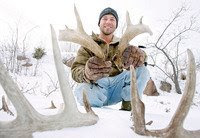
I came across this article a few days ago on Joe Shead displaying a group of deer antlers he had found on a Duluth hillside. He found his first shed antler eight years ago. Shead has written a book and produced a DVD about the practice of finding antlers shed by whitetailed deer. (Hansmeyer/ahansmeyer@duluthnews.com)
Shead, who lives in Superior, is looking for antlers. Like a growing number of Northland residents, he’s a “shed” antler hunter. He’s a collector of antlers that whitetail bucks shed naturally this time of year.
“After you find that first one, you’re hooked,” Shead said. “It’s kind of like an addiction. I’ll find one, and it’s a huge rush for a minute. Then it wears off, and you want another one.”
Shead — yes, it’s pronounced “shed” — has come to the aid of other shed-hunting addicts. He’s written a book on the subject called “Shed Hunting: A Guide to Finding White-Tailed Deer Antlers,” and he’s produced a DVD titled “Go Shed Hunting with Joe Shead.” He also has a website and a blog about sheds.
Shead — yes, it’s pronounced “shed” — has come to the aid of other shed-hunting addicts. He’s written a book on the subject called “Shed Hunting: A Guide to Finding White-Tailed Deer Antlers,” and he’s produced a DVD titled “Go Shed Hunting with Joe Shead.” He also has a website and a blog about sheds.
On this March afternoon, Shead scans a hillside well-traveled by deer within Duluth’s city limits.
“I can come here some days and see two dozen deer,” Shead says.
Hoof-pocked trails intertwine in the snow. They’re punctuated by deer droppings and the occasional melted oval of snow where a deer has bedded. Several times in the two-hour walk, Shead spies deer moving through the woods in the distance.
He said this is prime shed-hunting territory: A south-facing slope where deer love to be in the spring. Shead moves slowly, looking, looking.
Because this is public land, Shead knows other shed hunters work this area, too. “I come to this area probably three to four times a week because there are a lot of people in this area,” he says.
He comes to know some of the bucks that live here. He has nicknames for them based on the way their antlers grow.
In northern Minnesota, most deer breeding takes place in November, and whitetail bucks begin shedding their antlers in January and February.
“I got my first shed of the year under that little jack pine there,” Shead says. He points at the lone pine among the scrubby deciduous trees. Shead looks under all lone evergreen trees like the jack pine. He knows bucks like to rest under those isolated conifers, and there’s always a chance one might leave an antler behind.
So far, Shead has found eight antlers this spring. He estimates he has “a few hundred” antlers after finding his first one eight years ago. Although some shed hunters sell their antlers, Shead keeps all of his. He finds about 25 a year. He keeps the current season’s antlers and a few favorites on display.
“It’s very dangerous to walk across my living room floor,” he says.
I would love to find a shed. I need several billets for my flint knapping and antlers are great for that!
ReplyDeleteI will go check out his sight. Might find some hints to finding more sheds here. Thanks for sharing. ;)
ReplyDeleteI might just have to buy one of his products, since I have yet to find a shed. And with that last name, he was obviously born to shed hunt.
ReplyDelete